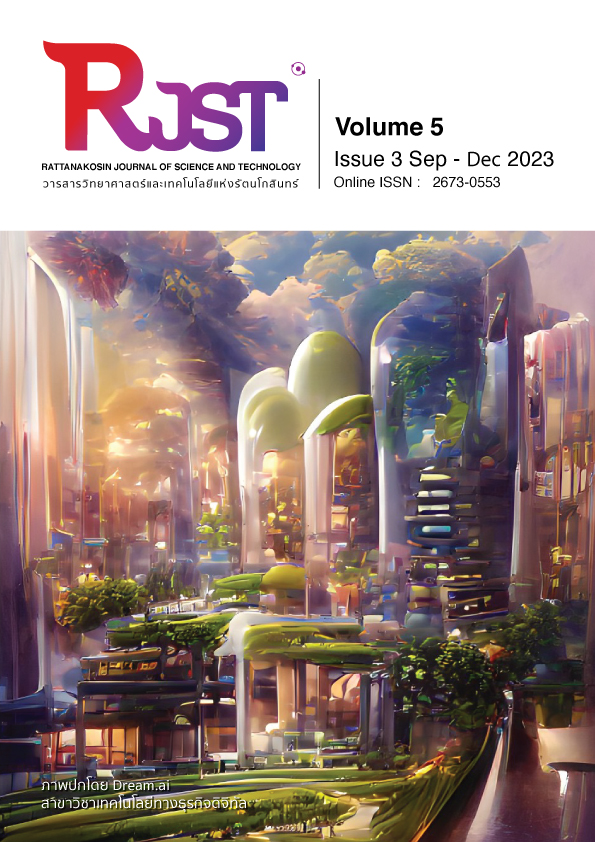Developing a composite Molding of a prototype electric vehicle wheel in competition using an autoclave system
Main Article Content
Abstract
This research is about developing a process for forming composite parts using an autoclave system. In this research, a prototype electric vehicle wheel was designed and formed using synthetic materials. Polyester resin (Polyester Resin), Polyurethane foam (PU Foam) and reinforced with carbon fiber fabric (Carbon Fiber) for the prototype energy-saving electric vehicle competition with the autoclave system. Using theories about air pressure, heat, and material strength. To make the carbon fiber wheel pieces come out according to the specified shape of the wheel and the wheel balance center to meet competition standards. In this research, three electric vehicle wheels were created by setting the pressure value for baking the workpiece when the first wheel was pressurized at +2 bar (15 psi), and the second wheel was pressurized at +1 bar (30 psi). and the third wheel is not pressurized. The research results were analyzed and divided into two topics: efficiency analysis and economic analysis. The research results can be summarized as follows. The performance of unpressurized carbon fiber wheels is that they explode when compressed with air at 65 psi, while pressurized wheels can be compressed at 75 psi. The economic analysis found that the process of forming composite parts with the autoclave system has a payback period of 2 months and ten days.
Article Details

This work is licensed under a Creative Commons Attribution-NonCommercial-NoDerivatives 4.0 International License.
The content within the published articles, including images and tables, is copyrighted by Rajamangala University of Technology Rattanakosin. Any use of the article's content, text, ideas, images, or tables for commercial purposes in various formats requires permission from the journal's editorial board.
Rajamangala University of Technology Rattanakosin permits the use and dissemination of article files under the condition that proper attribution to the journal is provided and the content is not used for commercial purposes.
The opinions and views expressed in the articles are solely those of the respective authors and are not associated with Rajamangala University of Technology Rattanakosin or other faculty members in the university. The authors bear full responsibility for the content of their articles, including any errors, and are responsible for the content and editorial review. The editorial board is not responsible for the content or views expressed in the articles.
References
กิตติศักดิ์ นักตรีพงษ์, ศิวกร เกิดแก้ว และภานุวัฒน์ พรหมพิทักษ์. (2557). ทำการขึ้นรูปบอดี้รถประหยัดพลังงานด้วยคาร์บอนไฟเบอร์, สาขาเทคโนโลยีเครื่องกล: มหาวิทยาลัยภัฏนครศรีธรรมราช (ออนไลน์).เข้าถึงได้จาก www2.nstru.ac.th (วันที่ค้นหาข้อมูล: 8 เมษายน 2566)
เฮนรี่ วีเลอร์, สกอตต์ ฮังเกอร์, แฟรงค์ ดับบลิวลี (ม.ป.พ.) ได้ทำการทดลองหม้อนึ่งภายใต้ความดันสุญญากาศการประมวลผลคอมโพสิต: สถาบันการศึกษาหลายหน่วยงานภาครัฐและอุตสาหกรรมคอมโพสิต (ออนไลน์). เข้าถึงได้จาก http://m.thai.aac-autolave.com (วันที่ค้นหาข้อมูล: 8 เมษายน 2566)
อมร พิมานมาศ (2557) นักวิจัยจากสถาบันเทคโนโลยีนานาชาติสิริรินธร ม.ธรรมศาสตร์ใน โครงการที่มีชื่อว่า “โครงการเสริมกำลังเสาต้านทานแผ่นดินไหวด้วยแผ่นคาร์บอนไฟเบอร์ [ออนนไลน์]. เข้าถึงได้จาก http://www.thaiseismc.com (วันที่ค้นหาข้อมูล: 9 เมษายน 2566)
โรเจอร์เบคอน (1958) สร้างเส้นใยคาร์บอน[ออนไลน์]. เข้าถึงได้จาก http://www.mkresin.com (วันทีค้นหาข้อมูล 9 เมษายน 2566)
Francesco Rondina, Sara Taddia, Laura Mazzocchetti, Lorenzo Donati, Giangiacomo Minak, Philipp Rosenberg, Andrea Bedeschi, Enrico Dolcini, “Development of full carbon wheels for sport cars with high-volume technology,” Composite Structures, Volume 192, Pages 368-378, (2018). ISSN 0263-8223. https://doi.org/10.1016/j.compstruct.2018.02.083 (https://www.sciencedirect.com/science/article/pii/S0263822318301818)
Alessandro Messana, Lorenzo Sisca, Alessandro Ferraris, Andrea Giancarlo Airale, Henrique de Carvalho Pinheiro, Pietro Sanfilippo and Massimiliana Carello. “From Design to Manufacture of a Carbon Fiber Monocoque for a Three-Wheeler Vehicle Prototype,”, “Materials”, Volume 12(3). Pages 332. (2019) DOI:10.3390/ma12030332
เศรษฐศาสตร์วิศวกรรม, กรุงเทพมหานคร: สำนักพิมหาวิทยาลัยธรรมศาสตร์ [5] [ออนไลน์]. เข้าถึงได้จาก http://riverolusblog.com/2011 (วันที่ค้นหาข้อมูล: 10 เมษายน 2566)
ฉนวนกันความร้อน. [ออนไลน์]. เข้าถึงได้จาก http: //www.tiheater.ac.th.(วันที่ค้นข้อมูล: 11 พฤศจิกายน 2566)
ชุดการเรียนรู้วิทยาศาสตร์และโลกดาราศาสตร์ (ม.ป.พ.), ความร้อนและอุณหภูมิ [ออนไลน์] เข้าถึงได้จาก: http://portal.edu.Chula.ac.th (วันที่ค้นหาข้อมูล:10 เมษายน 2566)
วริทธ์ อึ้งภากรร์ และชาญ ถนัดงาน (2521), การออกแบบเครื่องจักรกล, กรุงเทพมหานคร ซีเอ็ดยูเคชั้น จำกัด สุกิจนามพิชญ์. (2541). ความแข็งแรงของวัสดุ, ซีเอ็ดยูเคชั้น สุพรีม [ออนไลน์]เข้าถึงได้จาก http://mte. Kmutt. ac. th (วันที่ค้นหาข้อมูล: 10 เมษายน 2566)
Alexander Air, Md Shamsuddoha, Ebrahim Oromiehie & B. Gangadhara Prusty. “Development of an automated fibre placement-based hybrid composite wheel for a solar-powered car,” The International Journal of Advanced Manufacturing Technology. volume 125, pages 4083–4097 (2023)
Edited by Michelle M. Gauthier ASM DESK EDITIONS.BOOK CHAPTER Autoclave Molding DOI: https://doi.org/10.31399/asm.hb.emde.a0003041Published: 1995 ASM
InternationalDOI: https://doi.org/10.31399/asm.hb.emde.9781627082006ISBN electronic: 978-1-62708-200-6
Yaoji Industrial Investment (Shenzhen) Co., Ltd. “Carbon Fiber Parts ASME Standard Composite Autoclave,” [ออนไลน์]เข้าถึงได้จาก https://fj.china.com.cn/b2b/en/product/en_c_qoiortwrww.html. (วันที่ค้นข้อมูล: 11 พฤศจิกายน 2566)
MANSORY. Composite Autoclave Production. [ออนไลน์]เข้าถึงได้จาก https://www.mansory.com/manufactory. (วันที่ค้นข้อมูล:11 พฤศจิกายน 2566)
Takeshi Ashida. Autoclave molding method and autoclave molding apparatus. US8828309B2United States. United States Patent. Ashida.USOO88283 09B2(10) Patent No.: US 8,828,309 B2(45) Date of Patent: Sep. 9, 2014.
พัชรินทร์ อินทมาส มณีรัตน์ ชัยสกุลนิยม พเนตร์ สุขสิงห์ ธีระพงษ์ บุญรักษา และ พรหมพักตร์ บุญรักษา “การวิเคราะห์เชิงเทคนิคและความคุ้มค่าในการติดตั้งระบบผลิตไฟฟ้าพลังงานแสงอาทิตย์แบบติดตั้งบนหลังคาระดับครัวเรือน,” Rattanakosin Journal of Science and Technology: RJST2022, Volume 4Issue 3: 47-56.
Shell Eco-marathon Team, “Shell Eco-marathon 2018 Official Rules Chapter I” Shell Eco-marathon.


